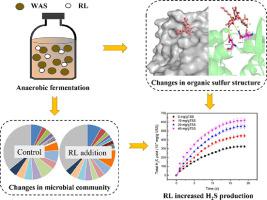Water Research ( IF 11.4 ) Pub Date : 2022-06-14 , DOI: 10.1016/j.watres.2022.118742 Qizi Fu 1 , Xuran Liu 1 , Dandan He 1 , Xuemei Li 1 , Chenxi Li 1 , Mingting Du 1 , Yan Wang 1 , Sha Long 1 , Dongbo Wang 1

|
Rhamnolipid (RL), one representative biosurfactant, is widely regarded as an economically feasible and environmentally beneficial additive to improve fermentation efficiency and resource recovery from waste activated sludge (WAS). However, its potentially detrimental impact on WAS fermentation such as H2S generation was overlooked previously. This study therefore aims to fill the gap through exploring whether and how the presence of RL affects H2S generation from WAS anaerobic fermentation. Experimental results showed that when RL increased from 0 to 40 mg/g total suspended solids (TSS), the cumulative H2S yield enhanced from 323.6 × 10−4 to 620.3 × 10−4 mg/g volatile suspended solids (VSS). Mechanism analysis showed that RL reduced WAS surface tension, which benefited transformations of organic sulfurs (e.g., aliphatic-S and sulfoxide) and inorganic sulfate from solid to liquid phase. The presence of RL not only reduced the ratio of α-helix/(β-sheet + random coil) and damaged the hydrogen bonding networks of organic sulfurs but also promoted substrate surface charges and cell membrane permeability. These facilitated the contact between hydrolase and organic sulfurs, thereby increasing sulfide production from organic sulfurs hydrolysis. Further investigations showed that RL promoted the expression of key genes (e.g., aprA/B and dsrA/B) involved in the dissimilatory sulfate reduction, which accelerated the reaction of adenosine 5’-phosphosulfate (APS) sulfite sulfide. Meanwhile, RL inhibited the corresponding key genes such as CysH, and Sir, responsible for assimilatory sulfate reduction (APS3’-phosphoadenosine-5’phosphosulfateorganosulfur), which reduced substrate competition in favor of H2S production from dissimilatory sulfate reduction. Besides, RL decreased the fermentation pH, which benefited the transformation of to H2S.
中文翻译:

鼠李糖脂会增加废活性污泥厌氧发酵产生的 H2S:一个被忽视的问题
鼠李糖脂 (RL) 是一种具有代表性的生物表面活性剂,被广泛认为是一种经济可行且对环境有益的添加剂,可提高发酵效率和从废弃活性污泥 (WAS) 中回收资源。然而,它对 WAS 发酵的潜在有害影响,例如 H 2 S 的生成,以前被忽视了。因此,本研究旨在通过探索 RL 的存在是否以及如何影响WAS 厌氧发酵产生H 2 S 来填补空白。实验结果表明,当RL从0增加到40 mg/g总悬浮固体(TSS)时,H 2 S的累积产率从323.6 × 10 -4增加到620.3 × 10 -4 毫克/克挥发性悬浮固体 (VSS)。机理分析表明,RL 降低了WAS 表面张力,有利于有机硫(例如脂肪族-S 和亚砜)和无机硫酸盐从固相转变为液相。RL的存在不仅降低了α-螺旋/(β-折叠+无规卷曲)的比例,破坏了有机硫的氢键网络,而且促进了底物表面电荷和细胞膜渗透性。这些促进了水解酶和有机硫之间的接触,从而增加了有机硫水解产生的硫化物。进一步的研究表明,RL 促进了关键基因(例如aprA/B和dsrA/ B) 参与异化硫酸盐还原,加速了腺苷 5'-磷酸硫酸盐 (APS) 的反应亚硫酸盐硫化物。同时,RL 抑制了相应的关键基因,如CysH和Sir,负责同化硫酸盐还原(APS3'-磷酸腺苷-5'磷酸硫酸盐有机硫),这降低了底物竞争,有利于通过异化硫酸盐还原产生 H 2 S。此外,RL降低了发酵pH,有利于转化为 H 2 S。











































 京公网安备 11010802027423号
京公网安备 11010802027423号